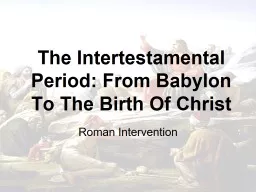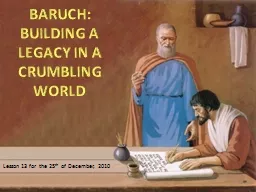PPT-The Intertestamental Period: From Babylon To The Birth Of C
Author : tawny-fly | Published Date : 2018-01-06
Roman Intervention Intertestamental Period Week Date Topic 1 01 Mar 17 Overview 2 08 Mar 17 Babylonian Period 605539 BC 3 15 Mar 17 Persian Period 539332 BC 4 22
Presentation Embed Code
Download Presentation
Download Presentation The PPT/PDF document "The Intertestamental Period: From Babylo..." is the property of its rightful owner. Permission is granted to download and print the materials on this website for personal, non-commercial use only, and to display it on your personal computer provided you do not modify the materials and that you retain all copyright notices contained in the materials. By downloading content from our website, you accept the terms of this agreement.
The Intertestamental Period: From Babylon To The Birth Of C: Transcript
Roman Intervention Intertestamental Period Week Date Topic 1 01 Mar 17 Overview 2 08 Mar 17 Babylonian Period 605539 BC 3 15 Mar 17 Persian Period 539332 BC 4 22 Mar 17 Greek Period 332323 BC. will be held during the final examination period and in the regularly scheduled classroom unless special room arrangements are made with the Registrar Thursday Evening Classes Thursday December 11 Tuesday Evening Classes Friday December 12 Wednesday The Second Empire. Significance of Babylon. “Babel” (Gen 11). Gains attention from many biblical authors. Isaiah, Ezekiel, Jeremiah, Habakkuk, Daniel, 2 Kings, others. Destroyed the temple; exiled Judah (586 B.C.). Lesson 13 for the 25. th. of December, 2010. HISTORICAL. CONTEXT. FINANCIAL. CONTEXT. “Like cages full of birds, . their houses are full of deceit; . they have become rich and powerful and have grown fat and sleek. . Background. Lesson 28:. The Babylonian Exile. The Babylonian Exile. MOAB. tribute. EDOM. tribute. AMMON. tribute. The Situation in Judah. The Devastation. All the major cities are destroyed. A vast number of Jews have been killed. Birth Place Married Place Death Place Birth Place Death Place Birth Death Birth Place Married Place Death Place Birth Place Married Place Death Place Birth Place Death Place Birth Birth Birth Place De The Two Empires of Mesopotamia. After the Sumerians were defeated, Mesopotamia had two main . empires. : Babylonia and Assyria. An empire is an area of many territories and people that are controlled by one government.. . crucifies. . Jesus. Legal and religious ties between Babylon . and Jerusalem that . lead up, in part, . to Jesus’ . death. Scripture Reading. Reader: . After this I saw another angel coming down from heaven, having great authority; and the earth was made bright with his splendor. He called out with a mighty voice,. Revelation 17-19. Lesson 158. It is easier to avoid temptation . than it is to resist temptation” --Elder Lynn G. Robbins. “The titles church of the devil and great and abominable church are used to identify all churches or organizations of whatever name or nature—whether political, philosophical, educational, economic, social, fraternal, civic, or religious—which are designed to take men on a course that leads away from God and his laws and thus from salvation in the kingdom of god.” (2). Maccabean Part 1. Intertestamental Period. Week. Date. Topic. 1. 01 Mar 17. Overview. 2. 08 Mar 17. Babylonian Period (605-539 BC). 3. 15 Mar 17. Persian Period (539-332 BC). 4. 22 Mar 17. Greek Period (332-323 BC). A . lian. Babylon . leh. . gulpi. . pawlteng. , . sapi. . leh. . zuau. . kamsang. . khempeuh. , a . tawpna. ah . kisusia. ding hi.. Eite. in a . mun. . mana. h . dingin. . suksiatna. . tawh. The Declaration . The declaration of the messenger. 1 After . these things I saw another angel coming down from heaven, having great authority, and the earth was illuminated with his glory. 2 . And . La gamme de thé MORPHEE vise toute générations recherchant le sommeil paisible tant désiré et non procuré par tout types de médicaments. Essentiellement composé de feuille de morphine, ce thé vous assurera d’un rétablissement digne d’un voyage sur . Sciences , Vol.(26), No.(6): 2018 143 A Study of the Association of Parental Consanguinity with Birth Defects and Neonatal Medical Problems in Babylon Province Sijal Fadhil Farhood Al - Joborae D Mexican Birth Certificate PSD template. Fully customizable layered PSD files. Put any Name, DOB, Certificate No., etc. to make your personalized Mexican Id.
Download Document
Here is the link to download the presentation.
"The Intertestamental Period: From Babylon To The Birth Of C"The content belongs to its owner. You may download and print it for personal use, without modification, and keep all copyright notices. By downloading, you agree to these terms.
Related Documents














